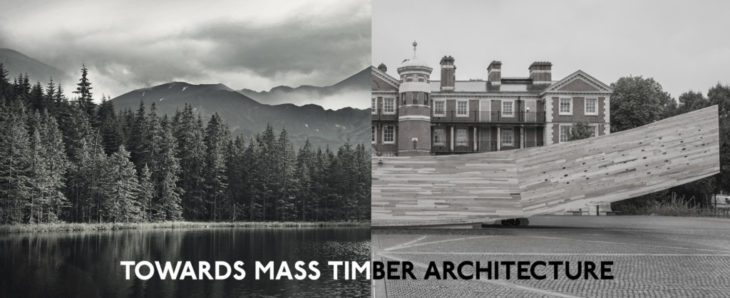Towards Mass Timber Architecture
Mass Timber: User’s Manual

Conceptual collage. Images from The Smile, Alison Brooks Architects, © Guy Bell
Abstract
“Forests are recognized around the world only to the extent that they are empty and wild, the shadows of civilization…. If forests are being destroyed, it is society; if they aren’t, it is nature: Everything can be explained by placing it somewhere in the dichotomy of social and
natural.” 1– Anna Lowenhaupt Tsing
Construction with timber has been accompanying us for centuries. However, the disclosure of the way of mass timber construction has not been established in our society so far. The approach of this abstract is to reach not only experts but citizens to have a better understanding of the advantages and disadvantages of construction with mass timber.
The impact on the environment of wood extraction is key to become aware of social needs for our present and immediate future. Wood is a renewable resource, nevertheless, without the proper understanding and management, exploitation is causing environmental impact and does not yet mitigate either minimize the carbon footprint. Understanding and improving the lifecycle of materials is key to reducing CO2 emissions on our planet, however, timber cannot only sequester CO2, but minimize the greenhouse effect.
Different strategies should be studied and carried out to acknowledge the impact on society of the understanding and use of timber.
To reach out to society with basic knowledge and understanding of construction with timber, it would be important to carry out small interventions, gatherings in cities where architects have a key role not only with designing but also communicating and showing the
benefits of building with timber. The implementation of ephemeral architecture would be a way; however, the specifics of design, production, costs, disassembly, and recycling should be described in every design to show its impact on the environment. Finally, since wood is a
natural resource, general opinion is not aware that using it for construction is sustainable indeed. Nonetheless, these studies will defer from country to country, yet the goal is to reach developed and developing countries’ needs.
Important as architects are for deciding the degree to which the future of construction would be, the decisions are somewhat out of sync with the scale and reach of the contemporary city we live in.

Conceptual collage. Image from The Final Wooden House, Sou Fujimoto Architects
Towards Mass Timber Architecture – Narratives is a project of IAAC, Institute for Advanced Architecture of Catalonia developed at MMTD in 2021/2022 by student Ricardo Cruz Recalde. Faculty: Daniel Ibáñez. Course: MMTD01 – Narratives